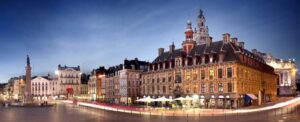DISCOVER LILLE, ONE OF FRANCE’S BEST-KEPT SECRETS
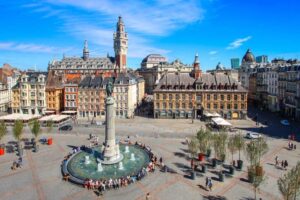
Capital of the Hautes-de-France region, Lille may be France’s most underrated city. Recent decades have seen the country’s 4th largest city transform from an industrial powerhouse into a vibrant and highly attractive cultural and commercial hub. Lille offers a beautiful old town with magnificent French and Flemish architecture, renowned art museums, a wide variety of great shops, outstanding cuisine, and a lively atmosphere thanks to a large population of university students and some 1600 designers in its environs. High speed direct trains from Paris and Brussels and 1½ hrs on Eurostar from London, makes Lille an easy choice for inclusion in a European itinerary.
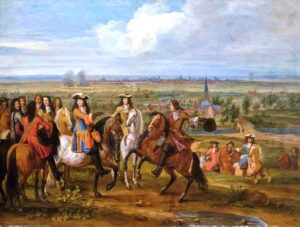
Vikings, Normans, Magyars and local princes overran this northern region from 830 to around 910 AD. The Burgundians, Holy Roman Emperor Charles V, Philip ll of Spain and the Hapsburgs all had their shot at control until 1668, when Louis XIV of France captured the city and Lille finally became French.
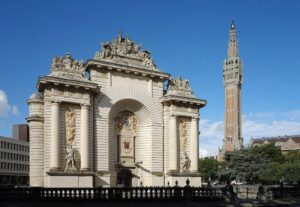
Lille is in two parts. The Vieille Ville (old city), and the more modern Greater Lille, outside the line of the ancient fortifications. Louis had some fortifications demolished, along with the old Porte des Malades (Gate of the Sick), and erected the Porte de Paris in its place. As its name suggests, Vieille Ville is the historic centre, with cobblestone streets lined with Baroque and Flemish bourgeois mansions.
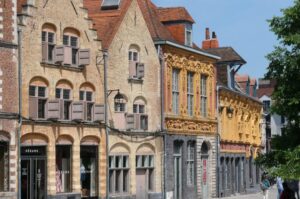
Today, the rejuvenated Vieille Ville is a particularly delightful place to wander its pleasant pedestrianised streets to discover its 17th & 18th century townhouses with their flamboyant, colourful façades and delicately gabled roofs. The old quarter also abounds in palaces and churches, offering a great insight into the city’s splendid past.
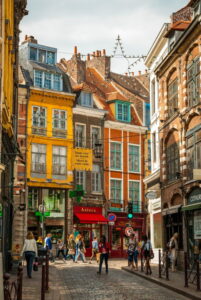
Historically, Lille’s architecture differs from that of other French cities. Prior to being invaded by Louis XIV in 1667, Lille was Flemish, which is evident in its red brick buildings, quite uncommon for the rest of the country.
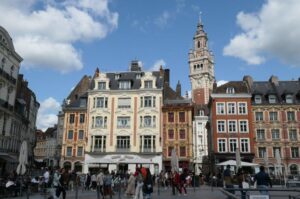
Starting at the main square, La Grande Place—also called Place du Général de Gaulle–the Vieille Bourse (old Commodity Exchange) building, facing onto the Place, is the city’s finest historic building, and a magnificent monument of Flemish Baroque dating from the 17th century. It consists of 24 Flemish houses, all around a central arcaded courtyard which is filled with bouquinistes, where you’ll find everything from antique books to second-hand novels and comics.

In 1066 the area of the Grand Place was referred to as the “forum”, and designated as a market square. The ground was drained, levelled and paved. In the 17th century, the Commodity Exchange divided the Place into the Main Place and the Petit Place. Today, it’s the city’s main gathering spot, a daily flower market, a venue for events, and the location for Lille’s second-hand book fairs, a major drawcard in the city, and demonstrations of tango dancing.
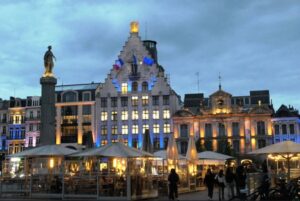
The Grand Place is surrounded by a number of fine buildings, including the Theatre du Nord, located in Lille’s former guardhouse, the Grande Guard, built in 1717 in the Flemish style. Decorating its façade is the sun emblem of Louis XIV. In the centre of the Place is the impressive Colonne de la Déesse, erected in the 19th century to commemorate the city’s part in repelling the Habsburg Empire in the Siege of Lille in 1792.
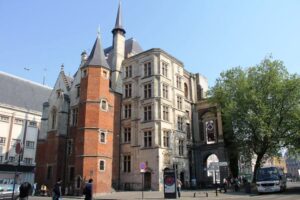
A few minutes away from the Vieille Bourse is the Palais Rihour, on the square of the same name. Built between 1453-1473 by Philippe le Bon, Duke of Burgundy, it is one of Lille’s rare vestiges of flamboyant Gothic architecture. Upstairs, the Conclave room and the sacristy have superb stained glass windows. Bought by the city in 1664, it served as the Hotel de Ville. A number of fires over the ensuing years necessitated the council moving to other premises, and nowadays, the Lille Tourist Office occupies the former Salle des Gardes. Well worth visiting. The square in front of the Palais Rihour-Tourist Office is the venue for Lille’s first-rate Christmas Market which takes place in December.

Aside from the Vieille Bourse, the city’s most prominent building is the Beffroi de l’Hôtel de Ville de Lille. This Art Deco building was constructed in the 1920s and took inspiration from Lille’s famous triangular gables. It was part of a reconstruction project to replace the old town hall, destroyed in WWl. It’s the tallest municipal building in France, with a belfry that has no bells, which begs the question: If no bells, why a belfry? The belfry rises to a height of over 103m, and there is a panoramic (if potentially windy) view from the top.
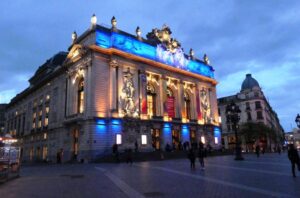
Located in Place du Theatre, just behind the Grand Place, the Opéra de Lille is a magnificent Neoclassical building, in perfect harmony with the neighbouring Chamber of Commerce and the Vieille Bourse. The theatre was built from 1907 to 1913, following the destruction by fire of the former opera house in 1903. The replacement Opera House is a Belle Epoque design featuring an elaborate pediment relief, and its interior is also very impressive, featuring works by a prominent sculptor of the day, Edgar-Henri Boutry. In 1914, during WWl, the occupying German forces stripped the still unfinished Opera House of its furniture and equipment in order to furnish another local venue, the Sebastopol Theatre. After the war, the building was restored and reopened its doors in 1923, rededicated as the Grand Theatre. Due to its poor physical condition, the building underwent a massive restoration in 1998, including improvements to its functional capacities. This work was completed in 2004, in time for Lille’s year as European Capital of Culture.
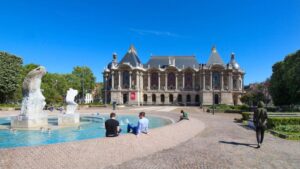
One thing not to be missed in Lille is a visit the Palais des Beaux-Arts, considered one of the finest museums in France, and second in size only to the Louvre in Paris. Renowned for its size and quality, this prestigious art collection is housed in an impressive building with a spacious and bright atrium. There’s an impressive collection of Old Masters, including Rubens, Van Dyck, Goya, Delacroix and David. There are also wonderful examples of 19th and 20th century French paintings, as well as a fine collection of Impressionist art, an antiquities collection and a sculpture gallery with pieces by Rodin among other artists. The museum has a very good gift shop and also offers casual dining and refreshment options at Le Beau Café.
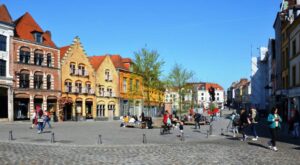
Rue de la Monnaie and Place Louise de Bettignies in the Vieille Ville are great places to stroll, and you’ll spend much of your walk looking up at the decorative façades and gables. The Place is named after Louise de Bettignies, a French secret agent who spied on the Germans for the British during WWl using the pseudonym of Alice Dubois. She was arrested in October 1915 while crossing the franco-German border using false papers after returning from England. She was imprisoned, dying in captivity shortly before the end of the war. She was posthumously awarded the Legion d’honneur, the Croix de guerre 1914-1918 and the British Military Medal, and was also made an Officer of the Order of the British Empire.

A visit to Meert patisserie & chocolate shop is a highlight of a visit to Lille.
Lille is renowned as a foodie destination. It has some of the best local specialties in the entire country. Have a meal at one of the local Estaminets. An Estaminet is a Flemish micro-brewery that serves the equivalent of pub food. They typically serve quite heavy meals with rich beer-based sauces, such as coq a la bière, and a variety of dishes made with the local, very pungent, maroilles cheese, such as a tarte au fromage. There are number of Estaminets in Vieux Lille, such as Estaminet Chez La Vieille in rue de Gand and Estaminet Aux Vieux de la Vieille in rue des Vieux Murs. Lille is also known for its chocolate, and one of the best patisseries is Le Merveilleux de Fred, which makes a famous chocolate dessert cake called Merveilleux. The queues which snake down the main street are indicative of its popularity. Or head to Méert at 27 rue Esquermoise, a tea-house where you can indulge in the decadent sweet treats for which they’ve been renowned since 1849.
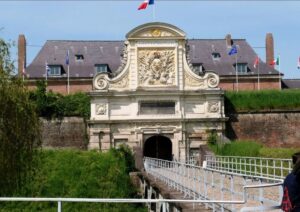
On the outer edge of Vieille Ville, at the northwestern end of Bvd de la Liberté, is the Citadelle de Lille, one of the city’s Must Sees. Shortly after capturing Lille from the Spanish, Louis XIV commissioned his military engineer and architect, Paul Vauban, to fortify the city and the border between France and Flanders.
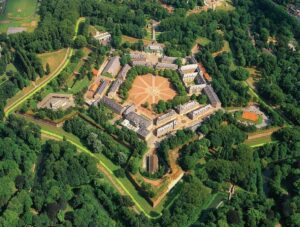
Referred to as the “Queen of Citadels”, Lille’s Citadelle was one of Vauban’s finest creations. It was a lynch-pin to a complex of fortifications, also designed by Vauban, which firmly secured France’s northern corner against invasion.
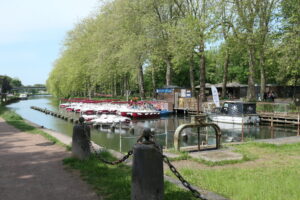
The Citadelle was situated on marshland between the rivers Deûle and Bucquet. With a system of locks and gates, the surrounding areas around it could be flooded without warning The fort is in the shape of a pentagon, which in turn is further defended by outer walls—a feature of Vauban’s military works. Several elements and components of the Citadelle have been classified as historic monuments in 1914, 1921 and 1934.
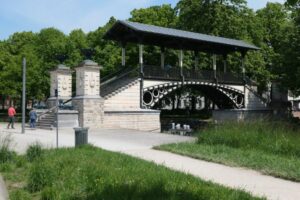
The whole complex is connected to the city by a wide esplanade, and the fort itself is set in vast wooded area that’s very well utilised by the locals for jogging, cycling or simply strolling. Access into the fort is via the Royal Gate.
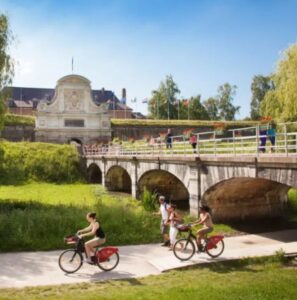
The heart of the Citadelle itself is not accessible to the public as it is still a military base and home to the Corps de réaction rapide France, along with personnel from 14 allied nations, within the framework of NATO.
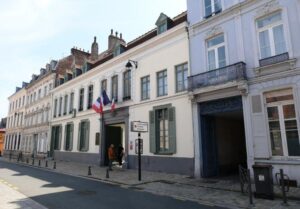
A few streets away from the Citadelle is the birthplace of Charles de Gaulle, who was born in Lille on 22 November 1890, and baptized at the nearby Église Saint-Andre. His birthplace and childhood home at 9 rue Princesse is a listed Historic Monument, as well as a “Maison des Illustres” (House of the Illustrious), in recognition of de Gaulle’s historical significance and political distinction. The home has been restored and converted into a museum.
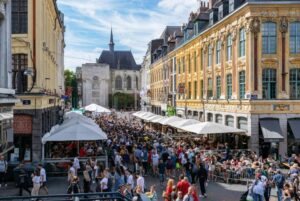
Lille is one of the best places to visit in Europe for flea market shopping. The city’s famous, and well-attended annual event, the Braderie de Lille, takes place the first weekend of September. The braderie (French for “low-price sale”) has been a tradition in Lille since the 12th century. The first flea market was held in 1127. By the 16th century, the braderie had become a much larger event with more participants, including servants who sold used items from the estates where they worked. More than 10,000 exhibitors sell their wares at open-air market stalls placed throughout the city. Items for sale include books, old records, vintage furniture, antique silverware and dinnerware and second-hand clothing, jewellery, artisan crafts and artwork. Besides the flea market, there are concerts and soirees, which gives the event a very convivial ambience. The Braderie also features a food and drink fair plus carnival rides for kids. Visitors can enjoy the local street food, including mussels, French fries, grilled fish and other regional specialties. The next Braderie will be held on 02 – 03 September.
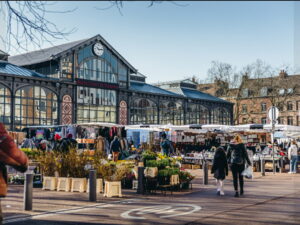
No visit to Lille would be complete without a visit to the famous Marché de Wazemmes. Located about 1.50 kms to the southeast of the city centre in a diverse working class quartier, it’s one of the biggest markets in all of France, with an incredible array of fresh produce, meat, cheese and bread, as well as flowers, and fabric. It’s held at Place Nouvelle Aventure on Tuesday, Thursday and Sunday mornings. Of the three, Sunday is the most vibrant and colourful, when there are hundreds of stalls and thousands of people show up to browse and buy. You will become immediately aware of the scent of wonderful spices, as well as exotic fruits and vegetables, used in North African and Middle Eastern cuisine. However, you can find anything you desire, from rotisserie chicken hot from the spit to antiques, the freshest vegetables and even clothing. The market is surrounded by many bars and cafes where you can relax with a good lunch and other refreshments.
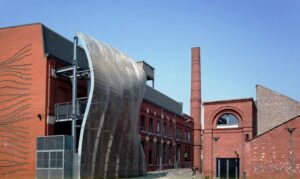
In this neighbourhood, in rue des Sarrazins, one of Lille’s massive textile mills has been transformed into a modern cultural centre called Maison Folie Wazemmes. It’s a red brick former factory dating from 1855, and in 2004, a Dutch architectural company re-evaluated the two remaining buildings to create a new landmark for the city. The resultant contemporary design harmonises with the 19th century architecture very well. There’s more than 5,000 sq.m. for exhibitions, and an auditorium with seating for 250 and standing room for more than 700. You’ll know you’ve arrived at the right place when you’re confronted with the sinuous sheet metal façade.

For those interested in touring the WWl battlefields of the Western Front, Lille is a very good base. Some of the main sites are the Somme, which is about an hour’s drive from Lille; Fromelles, which was the site of the bloodiest battle in Australia’s history of warfare; Ypres, and although there no tour from Lille, there is from nearby Arras. Enquire at the Lille Tourist Office for further information and about possible tours.
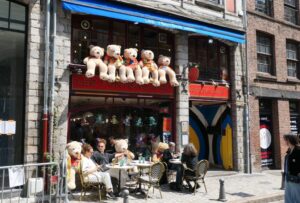
There are two outstanding attractions in Roubaix, in the suburbs of Lille, that have been declared World Heritage Sites, which I’ll talk about in the next story.
